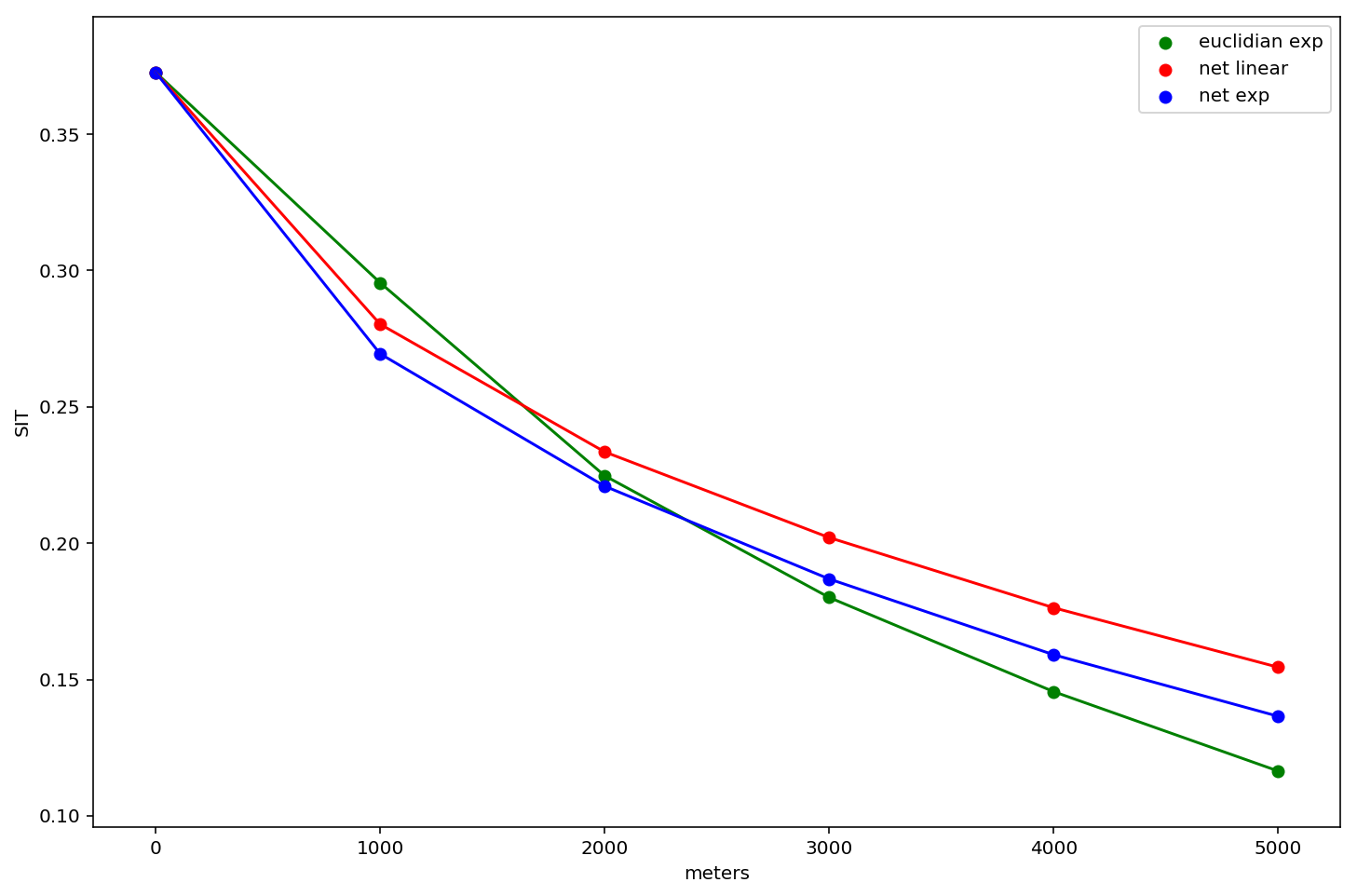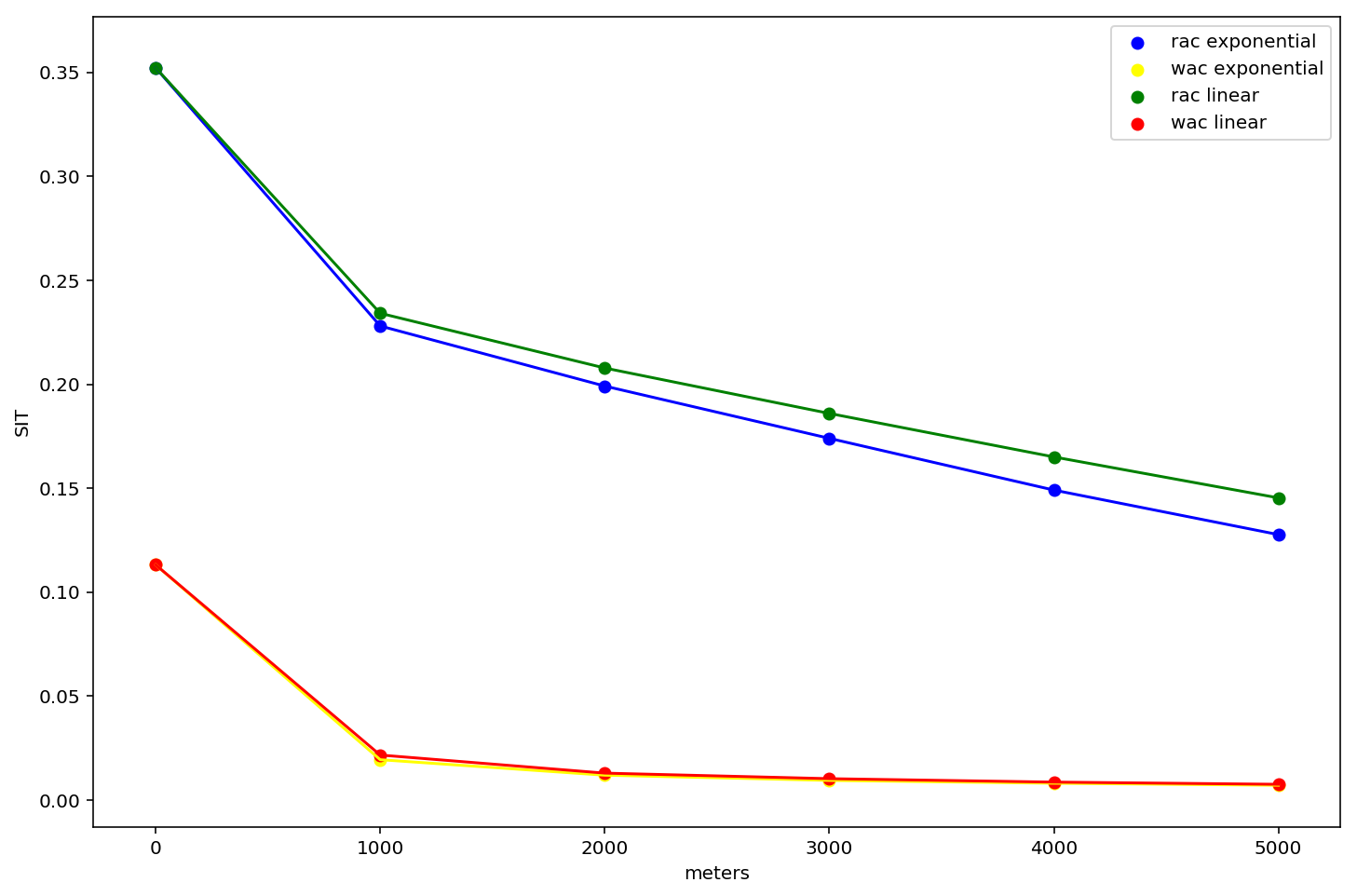This notebook examines how different definitions of urban space can affect observed measures of segregation. Using the spatial information theory index (H), we look at how different definitions of the local environment affect values of H for the same study area and population groups. Next, we calculate multiscalar segregation profiles introduced by Reardon et al to examine differences between macro and micro segregation. Finally, we examine how these segregation profiles differ when we measure distance in the local environment as a straight line, versus along a pedestrian transport network
Note I highly recommend installing pandana as a multithreaded library following these instructions. The notebook will still run if you intall from pip or anaconda, but the network computations will take considerably longer
import geopandas as gpd
from segregation.aspatial import Multi_Information_Theory
from segregation.spatial import SpatialInformationTheory
from segregation.network import get_osm_network
from segregation.util import compute_segregation_profile
from libpysal.weights import Queen, Rook, Kernel
from geosnap.data import Community
from geosnap.data.data import get_lehd
from pandana.network import Network
from pysal.viz.splot.libpysal import plot_spatial_weights
import matplotlib.pyplot as plt
%matplotlib inline
%load_ext autoreload
%autoreload 2
First, we'll get census 2010 data from geosnap and project into state plane (so we have planar units for the kernel weights constructor)
dc = Community(source='ltdb', statefips='11')
df = dc.tracts.merge(dc.census[dc.census['year']==2010], on='geoid')
df = df.to_crs(epsg=6487)
df.plot()
Note: there are likely to be some nontrivial edge effects since we're truncating the data artificially at the DC border
kernel weights operate on points, so we'll abstract each polygon to exist at its mathematical center
df_pts = df.copy()
df_pts['geometry'] = df_pts.centroid
We define local environments using spatial weights matrices that encode relationships among our units of observations. Weights matrices can take many forms, so we can choose how to parameterize the environment. Here' we'll examine two contiguity weights, "queen" and "rook", which mean that the local environment of each census tract is the tract itself, and the adjacent tracts sharing either a vertex or side (queen) or just a side (rook). We'll also use kernel distance-based weights. This type of weights matrix considers the local environment to be all tracts that fall within a specified distance of the focal tract, but applies a distance decay function so that tracts further away have a smaller affect than tracts nearby. The network-based weights we'll examine later also work this way.
Here, we'll create 4 different weights matrices: queen, rook, 1km euclidian kernel, and 2km euclidian kernel
w_queen = Queen.from_dataframe(df)
w_rook = Rook.from_dataframe(df)
w_kernel_1k = Kernel.from_dataframe(df_pts, bandwidth=1000)
w_kernel_2k = Kernel.from_dataframe(df_pts, bandwidth=2000)
fig, ax = plt.subplots(1,4, figsize=(16,4))
plot_spatial_weights(w_queen, df, ax=ax[0])
ax[0].set_title('queen')
plot_spatial_weights(w_rook, df, ax=ax[1])
ax[1].set_title('rook')
plot_spatial_weights(w_kernel_1k, df, ax=ax[2])
ax[2].set_title('kernel 1k')
plot_spatial_weights(w_kernel_2k, df, ax=ax[3])
ax[3].set_title('kernel 2k')
these plots show us which tracts are considered neighbors with each other using each type of weights matrix. Internally, segregation uses the build_local_environment function to turn these weights matrices into localized data. The different relationships implied by each matrix result in significantly different local environments as shown below
we'll measure H as a function of 4 racial categories, and we'll plot the non-hispanic black population to get a sense for how these local environments vary
groups = ['n_nonhisp_white_persons', 'n_nonhisp_black_persons', 'n_hispanic_persons', 'n_asian_persons']
from segregation.spatial.spatial_indexes import _build_local_environment
def plot_local_environment(w, ax):
d = _build_local_environment(df, groups, w)
d['geometry'] = df.geometry
d = gpd.GeoDataFrame(d)
d.plot('n_nonhisp_black_persons', k=6, scheme='quantiles', ax=ax)
ax.axis('off')
fig, axs = plt.subplots(1,4, figsize=(16,4))
for i, wtype in enumerate([w_queen, w_rook, w_kernel_1k, w_kernel_2k]):
plot_local_environment(w=wtype, ax=axs[i])
again, note that this is slightly misleading since in this toy example we're not including data from Maryland and Virigina that would otherwise have a big impact on the "local environment" values displayed here
And, as we might expect, these different local environments result in different segregation statistics
# aspatial
Multi_Information_Theory(df, groups).statistic
# rook neighborhood
SpatialInformationTheory(df, groups, w=w_rook).statistic
# queen neighborhood
SpatialInformationTheory(df, groups, w=w_queen).statistic
# 1 kilometer kernel distance neighborhood
SpatialInformationTheory(df, groups, w=w_kernel_1k).statistic
# 2 kilometer kernel distance neighborhood
SpatialInformationTheory(df, groups, w=w_kernel_2k).statistic
As we increas the distance on the kernel density weights, we get a sense for how segregation varies across scales. Following Reardon et al, We can calculate H for a set of increasing distances and plot the results to get a sense of the variation in macro versus micro segregation. segregation provides the compute_segregation_profile function for that purpose. You pass a dataframe, a list of distances, and a set of groups for which to calculate the statistics
distances = [1000.,2000.,3000.,4000.,5000.] # note these are floats
euclidian_profile = compute_segregation_profile(df_pts, groups=groups, distances=distances)
euclidian_profile
The drawback for kernel density weights is that urban space is not experienced in a straight line, but instead conditioned by transport networks. In other words, the local street network can have a big impact on how easily a person may come into contact with others. For that reason, segregation can also calculate multiscalar segregation profiles using street network distance. We include the get_osm_network function for downloading street network data from OpenStreetMap
# convert back to lat/long and get an OSM street network
df = df.to_crs(epsg=4326)
note it can take awhile to download a street network, so you can save and read it back in using pandana
#net = get_osm_network(df)
#net.save_hdf5('dc_network.h5')
net = Network.from_hdf5('dc_network.h5')
network_linear_profile = compute_segregation_profile(df_pts, groups=groups, network=net, distances=distances)
network_exponential_profile = compute_segregation_profile(df_pts, groups=groups, network=net, distances=distances, decay='exp', precompute=False)
# we're using the same network as before, so no need to precompute again
import matplotlib.pyplot as plt
We now have three different segregation profiles:
- an exponential kernel in euclidian space
- an exponential kernel in network space
- a linear kernel in network space
lets plot all three of them and examine the differences
fig, ax = plt.subplots(figsize=(12,8))
ax.scatter(euclidian_profile.keys(), euclidian_profile.values(), c='green', label='euclidian exp')
ax.plot(euclidian_profile.keys(), euclidian_profile.values(), c='green')
ax.scatter(network_linear_profile.keys(), network_linear_profile.values(), c='red', label='net linear')
ax.plot(network_linear_profile.keys(), network_linear_profile.values(), c='red')
ax.scatter(network_exponential_profile.keys(), network_exponential_profile.values(), c='blue', label='net exp')
ax.plot(network_exponential_profile.keys(), network_exponential_profile.values(), c='blue')
plt.xlabel('meters')
plt.ylabel('SIT')
plt.legend()
plt.show()
These results are interesting and show that measured levels of segregation differ according to the analyst's operationalization of space/distance. In general, the network kernels tend to estimate higher levels of segregation, and the euclidian distance has the steepest slope
Here, we'll examine how segregation profiles vary by time of day by calculating multiscalar measures for both workplace populations (i.e. daytime) and residential populations (i.e. night time). We'll use more detailed block-level data from LEHD, and we will compare how the profiles differ when we measure using network distance, but weight further observations using a linear decay function versus an exponential decay.
Again, we'll read in the data, convert to a point representation, and project into state plane for our calculations. Well use the get_lehd convenience function from geosnap to quickly collect block-level attributes for workplace and residential populations
# you can download this file here: https://www2.census.gov/geo/tiger/TIGER2018/TABBLOCK/tl_2018_11_tabblock10.zip
blks = gpd.read_file('zip://tl_2018_11_tabblock10.zip')
blks['geometry'] = blks.centroid
blks = blks.to_crs(epsg=6487)
# we need both workplace area characteristics (wac) and residence area characteristics (rac)
de_wac = get_lehd('wac', state='dc', year='2015')
de_rac = get_lehd('rac', state='dc', year='2015')
# https://lehd.ces.census.gov/data/lodes/LODES7/LODESTechDoc7.3.pdf
# white = CR01
# black = CR02
# asian = CR04
# hispanic = CT02 - guessing these arent exclusive,
# lets just do white-black in this case
groups_lehd = ['CR01', 'CR02']
blks_wac = blks.merge(de_wac, left_on='GEOID10', right_index=True)
blks_rac = blks.merge(de_rac, left_on='GEOID10', right_index=True)
rac_net = compute_segregation_profile(blks_rac, distances=distances, groups=groups_lehd, network=net, precompute=False)
wac_net = compute_segregation_profile(blks_wac, distances=distances, groups=groups_lehd, network=net, precompute=False)
rac_net_exp = compute_segregation_profile(blks_rac, distances=distances, groups=groups_lehd, network=net, decay='exp', precompute=False)
wac_net_exp = compute_segregation_profile(blks_wac, distances=distances, groups=groups_lehd, network=net, decay='exp', precompute=False)
fig, ax = plt.subplots(figsize=(12,8))
ax.scatter(rac_net_exp.keys(), rac_net_exp.values(), c='blue', label='rac exponential')
ax.plot(rac_net_exp.keys(), rac_net_exp.values(), c='blue')
ax.scatter(wac_net_exp.keys(), wac_net_exp.values(), c='yellow', label='wac exponential')
ax.plot(wac_net_exp.keys(), wac_net_exp.values(), c='yellow')
ax.scatter(rac_net.keys(), rac_net.values(), c='green', label='rac linear')
ax.plot(rac_net.keys(), rac_net.values(), c='green')
ax.scatter(wac_net.keys(), wac_net.values(), c='red', label='wac linear')
ax.plot(wac_net.keys(), wac_net.values(), c='red')
plt.xlabel('meters')
plt.ylabel('SIT')
plt.legend()
plt.show()
A few things to take in here:
- these curves are significantly different from the tract-based profiles above.
- They are different years, different populations, and different aggregation levels, so we expect them to be (but it raises the question which of these variables is causing the difference?)
- residential segregation is so much larger than workplace segregation
- in fact, workplace segregation in DC is essentially 0 for environments greater than 1km
- the residential curve falls faster for exponential decay (as we might expect)
- there's almost no discernible differece between workplace areas segregation profiles using different decay types
what might this say about transport equity and spatial mismatch?





